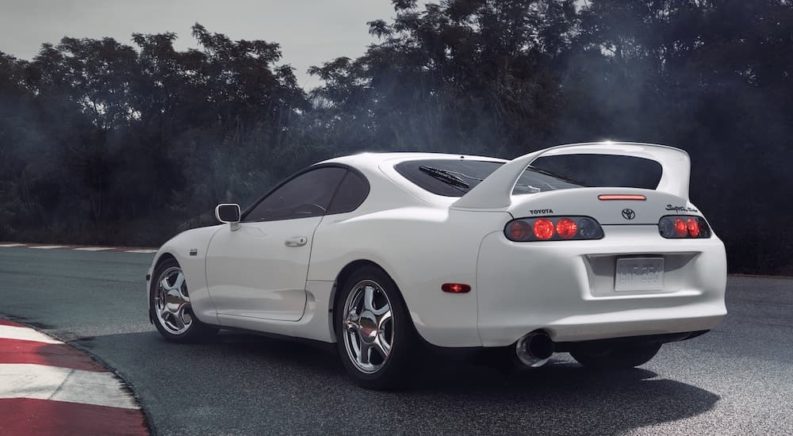The 1990s represent a golden age of sorts for vehicles. Vehicle manufacturers were cranking out high-quality cars left and right, and the Japanese Domestic Market (JDM) was especially enjoying exponential growth. Cars weren’t just vehicles, they were a culture and way of life, and that culture had never been more expansive than it was in the ‘90s. Legendary vehicles with cult followings were made aplenty during this decade, so much so that when perusing for a ‘90s car at a used vehicle dealership, you may find just as many “classics” as you do “beaters.” If you’ve been following Car Life Nation for a while, you will have seen my opinions on the best cars of the 1970s and the 1980s, but it’s time to move to the future. Here are my favorite cars of the 1990s, split into six categories: performance, economy, style, cultural impact, utility, and most interesting.
Performance – 1998 McLaren F1
The McLaren F1 was the first vehicle designed by McLaren meant to be driven on the road instead of the racetrack, and it’s regarded by many as the greatest car ever made. It might be a little unfair to include a 1998 McLaren F1 and a 1998 Honda Civic in the same article (spoiler alert), considering the going price of a 1998 Honda Civic was around $20,000 while a brand new 1998 McLaren F1 could cost as much as $1,000,000. Today, you could probably get on Craigslist and trade a good push mower for a ‘90s Honda Civic; meanwhile, a 1995 McLaren F1 recently sold at auction for $20,500,000. It turns out, everyone who could afford one in the ‘90s is positioned to get a wildly good return on their investment. I’m happy for you, Jay Leno.
The McLaren F1 was powered by a naturally-aspirated V12 engine since the designer, Formula One’s Gordon Murray, regarded them as more reliable than the turbocharged variety. In 1998, the McLaren F1 set the record for the world’s fastest car, clocking in at 242.8 mph. Its performance can be credited in part to the painstaking effort that went into maximizing the aerodynamics of the vehicle. Little tweaks here and there, like using thinner leather for the interior and lightweight tools for the tool kit, made sure every little bit of excess weight was trimmed off. The driver’s seat was positioned smack dab in the middle, with one passenger seat flanking each side. The driver-centric design maximized visibility and kept with the overall symmetry and balance of the vehicle.
Economy – 1998 Honda Civic
When someone says “economy sedan,” the Honda Civic is probably one of the first cars that pops into your mind, but in the ‘90s, the Civic spread its wings to show it had more to offer the world than a cheap and reliable ride from point A to point B. The Honda Civic Si was introduced in the late ’80s and rose to feverish popularity throughout the ‘90s. Meanwhile, the very first Honda Civic Type R – Honda’s high-performing Civic with a devoted fan base – made its first appearance in 1997 in Japan. The Honda Civic GX debuted in 1998, becoming the first vehicle fueled by natural gas to be sold to non-commercial customers in the United States. Aside from these Civic varieties, the classic Honda Civic was crushing it in the ‘90s. There was a Civic for everybody, whether you were looking for a sedan, coupe, or hatchback. Reliability and expansive options for body styles, engines, and transmissions, made (and continue to make) the Honda Civic a popular choice for a wide range of buyers.
Style – 1999 Mazda Miata
The second generation of the little roadster known as the Mazda Miata debuted for the 1999 model year. The design changes were subtle, the most noticeable difference being buggy, wide-eyed headlights swapped in for the pop-up headlights of the first generation. In fact, the exterior design of the Mazda Miata has been surprisingly consistent for the past 30+ years. If it ain’t broke, don’t fix it, right? The two-seater, open-top Mazda Miata takes style notes from old British roadsters, most notably the Lotus Elan. It’s a car made for cruising around, the type of vehicle that everyone looks cool in. The 1999 Miata had clean lines and a simplicity of design that is timelessly pleasing, plus a grille reminiscent of a goofy smile that didn’t look out of place in the slightest. Sports cars are often embellished with aggressive features (so you know how fast they are), but the 1999 Miata didn’t have a mean bone in its body, and the public has been crushing on it since the vehicle’s debut.
Cultural impact – 1994 Toyota Supra
The 1990s-era Toyota Supra is nothing short of a legend. It had two engine options: a naturally-aspirated 3.0-liter I6 and a turbocharged 3.0-liter I6. The latter is one of the most beloved engines amongst tuners, on account of its ability to withstand way more power than its factory 320 hp. Simple modifications ramped the 2JZ-GTE’s power output to something closer to 1000 hp, which is no problem for the engine since it was built with high-quality, strong materials. This paired with a 6-speed manual transmission, understated looks, and a big wing skyrocketed the Toyota Supra to stardom. Even Hollywood took notice, making it one of the vehicles driven by Paul Walker in the Fast and Furious franchise. The Toyota Supra had a reputation that it could back up, and it became an icon in car culture.
Utility – 1998 Chevy Astro
Full disclosure: the 1998 Chevy Astro is not an unbiased choice for the most utilitarian vehicle of the ‘90s. It was the van that my grandparents toted us kids around in, and it withstood many a road trip and surprise puking. It was so big that it practically felt like a whole house. During my research, I’ve found out that it wasn’t a particularly safe vehicle (which I will be having a conversation with my grandparents about), but it sure could fit a lot of people in it and comfortably. The van still runs, despite its age, and I always get a warm and fuzzy feeling whenever I see it.
Nostalgia aside, there’s a reason why the Chevy Astro was a popular choice amongst families and businesses alike. It’s huge! With cargo space of up to 170.4 cu.ft., it was large enough to fit your family of eight with room to spare or your burgeoning catering business. The usefulness of the Chevy Astro has even carried over into the modern age, being a popular choice for those who have lived the “van life,” which involves furnishing the interior of a large van into a living space instead of a conventional, stationary apartment. The Chevy Astro has taken on a new life in the modern age, becoming symbolic of a type of nomadic freedom. It’s even got a song named after it, written by an indie band.
Most Interesting – GM EV1
GM’s EV1 was the first mass-produced electric vehicle, produced from 1996–1999. The car was designed with aerodynamics in mind, smoothed out for slipping through the air in an effort to preserve energy. Rear fender skirts added to the vehicle’s aerodynamic and distinctive look. It’s range of 70-90 miles is far outmatched by modern electric vehicles, but at the time, it was revolutionary. GM sold the EV1 strictly as a lease, with no option to purchase the vehicle. In 2002, GM notified EV1 lessees that they would be taking the cars back, citing high production costs as their reason for terminating the EV1 line. Several EV1 drivers sent letters to GM, pleading for their leases to be extended, but GM began reclaiming the vehicles in 2003. Some were donated to museums, but the large majority of the 1,117 EV1s that were produced were destroyed. GM’s decision to discontinue the EV1 proved to be a controversial one, inspiring several conspiracy theories that attributed GM’s decision to villainous intentions.
Regardless of GM’s motivation for killing the EV1, other vehicle manufacturers like Honda and Toyota soon filled the gap, proving there was, in fact, a market for a cleaner vehicle.




